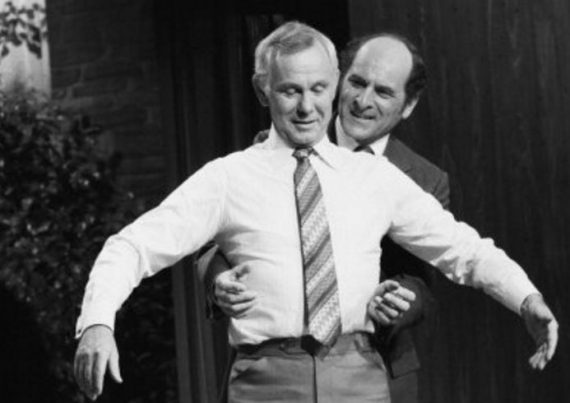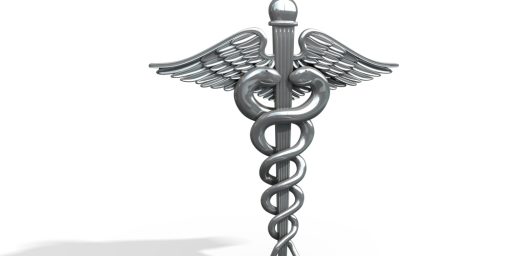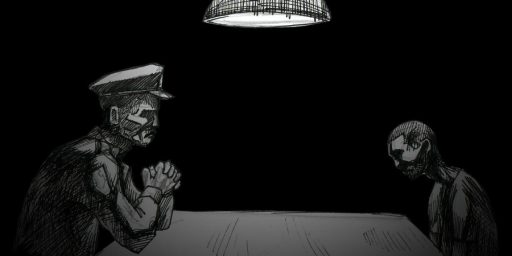Dr. Henry Heimlich, Inventor Of Technique That Has Saved Thousands Of Lives, Dies At 96
The doctor who developed a now universal technique to save the life of someone who is choking on an object lodged in their throat has died at the age of 96:
It is called the Heimlich maneuver — saving a choking victim with a bear hug and abdominal thrusts to eject a throat obstruction — and since its inception in 1974 it has become a national safety icon, taught in schools, portrayed in movies, displayed on restaurant posters and endorsed by medical authorities.
It is also the stuff of breathless, brink-of-death tales, told over the years by Ronald Reagan, Edward I. Koch, Elizabeth Taylor, Goldie Hawn, Cher, Walter Matthau, Halle Berry, Carrie Fisher, Jack Lemmon, the sportscaster Dick Vitale, the television newsman John Chancellor and many others.
Dr. Henry J. Heimlich, the thoracic surgeon and medical maverick who developed and crusaded for the antichoking technique that has been credited with saving an estimated 100,000 lives, died on Saturday at a hospital in Cincinnati after suffering a heart attack at his home there last Monday, his family said. He was 96.
More than four decades after inventing his maneuver, Dr. Heimlich used it himself on May 23 to save the life of an 87-year-old woman choking on a morsel of meat at Deupree House, their senior residence in Cincinnati. He said it was the first time he had ever used the maneuver in an emergency, although he had made a similar claim in 2003.
Patty Ris, who had by chance sat at Dr. Heimlich’s table in a dining hall, began eating a hamburger. “And the next thing I know, I could not breathe I was choking so hard,” she said later. Recognizing her distress, Dr. Heimlich did his thing. “A piece of meat with a little bone attached flew out of her mouth,” he recalled.
While best known for his namesake maneuver, Dr. Heimlich developed and held patents on a score of medical innovations and devices, including mechanical aids for chest surgery that were widely used in the Vietnam War, procedures for treating chronic lung disease and methods for helping stroke victims relearn to swallow. He also claimed to have invented a technique for replacing a damaged esophagus, but later acknowledged that a Romanian surgeon had been using it for years.
A professor of clinical sciences at Xavier University in Cincinnati and president of the Heimlich Institute, which he founded to research and promote his ideas, Dr. Heimlich was a media-savvy showman who entered the pantheon of medical history with his maneuver but in later years often found himself at odds with a medical establishment skeptical of his claims and theories.
Even the Heimlich maneuver, when he first proposed it, was suspect — an unscientific and possibly unsafe stunt that might be too difficult for laymen to perform and might even cause internal injuries or broken bones in a choking victim.
But the stakes were high. In the 1970s, choking on food or foreign objects like toys was the sixth-leading cause of accidental death in America: some 4,000 fatalities annually, many of them children. A blocked windpipe often left a victim unable to breathe or talk, gesturing wildly to communicate distress that mimicked a heart attack. In four minutes, an oxygen-starved brain begins to suffer irreversible damage. Death follows shortly thereafter.
Standard first aid for choking victims, advocated by the American Red Cross and the American Heart Association, was a couple of hard slaps on the back or a finger down the throat. But Dr. Heimlich believed those pushed an obstruction farther down in the windpipe, wedging it more tightly. He knew there was a reserve of air in the lungs, and reasoned that sharp upward thrusts on the diaphragm would compress the lungs, push air back up the windpipe and send the obstruction flying out.
His solution — wrapping arms around a victim from behind, making a fist just over the victim’s navel and thrusting up sharply — worked on dogs. His ideas, published in The Journal of Emergency Medicine in an informal article headlined “Pop Goes the Cafe Coronary,” were met with skepticism.
Anticipating resistance from his peers, Dr. Heimlich sent copies to major newspapers around the country. Days later, a Washington State man who had read about it used the maneuver to save a neighbor.
There were other cases and more headlines. A 5-year-old Massachusetts boy saved a playmate after seeing the maneuver demonstrated on television. Testimonials flooded in. Dr. Heimlich was on his way to celebrity.
In a profession that frowned on self-promotion, he was regarded as a publicity-seeking eccentric, if not a crackpot. But as saved lives accumulated into a mountain of evidence, skeptics were mollified, state and federal health authorities endorsed the technique, and its popularity spread. Today it is known to millions from the internet, television, films, pamphlets, books, newspapers and magazines, talked up in families and taught in schools, often with videos provided by the Heimlich Institute.
No one knows how many lives have been saved by the procedure, although reported choking deaths declined after its popularization. The Heimlich Institute claims 50,000 lives saved in the United States alone. A 2009 Op-Ed article in The New York Times estimated that 100,000 people had been rescued from choking. The American Medical Association, which endorsed the technique in 1975 and gave it the name Heimlich maneuver, says it saves unknown thousands annually.
(…)
Henry Judah Heimlich was born on Feb. 3, 1920, in Wilmington, Del., to Philip and Mary Epstein Heimlich. The family soon moved to New Rochelle, N.Y., where he attended public schools. His father was a prison social worker, and Henry sometimes went along on his rounds.
He received a bachelor’s degree from Cornell University in 1941 and a medical degree from Cornell Medical College in New York City in 1943. He interrupted an internship at Boston City Hospital to join the Navy in World War II. He served with Chinese guerrillas in the Gobi Desert and Inner Mongolia. After the war he was a resident at several hospitals in New York City, and in 1950 he joined Montefiore Hospital in the Bronx.
In 1951 he married Jane Murray, the daughter of the dance studio entrepreneur Arthur Murray. They had twin daughters, Janet and Elisabeth, and two sons, Philip and Peter.
Dr. Heimlich’s survivors include his children and several grandchildren. Jane Heimlich, who co-wrote a book on homeopathy and wrote “What Your Doctor Won’t Tell You” (1990), about alternative medicine, died in 2012.
In 1955, Dr. Heimlich proposed a method of restoring a patient’s lost ability to swallow, a condition called dysphagia, by reconstructing a damaged or diseased esophagus, using a section of the patient’s stomach. While the condition condemned victims to a lifetime of drooling and taking nourishment through an implanted tube into the stomach, his paper in the journal Surgery was virtually ignored in America. But a Romanian surgeon, Dr. Dan Gavriliu, wrote to Dr. Heimlich and said he had been using the procedure for four years.
At the invitation of the Romanian Academy of Sciences, Dr. Heimlich visited Bucharest in 1956 to review the procedure. He returned to New York, successfully tried the operation, and it became a standard procedure in America. “Without question, Dr. Dan Gavriliu deserves credit for being the first surgeon to discover and perform the procedure that would come to be known as the Heimlich-Gavriliu Reversed Gastric Tube operation,” Dr. Heimlich wrote in a memoir.
In the early 1960s Dr. Heimlich invented a device to drain fluid from an open chest wound. Operating on battlefields in World War II, he had seen a need for something better than a standard drainage bottle with suction to pump air and fluid from an open chest. The key was a valve that would control air and prevent fluids from flowing back into the wound.
In a dime store, he found a Japanese-made toy noisemaker with a flutter valve. It worked in his device, and he took out a patent on what he called the Heimlich Chest Drain Valve. Widely used by medics on Vietnam battlefields, it also became common in civilian chest operations. By 1989, manufacturers reported annual sales of 250,000 worldwide.
In 1969 Dr. Heimlich became director of surgery at the Jewish Hospital in Cincinnati, and in 1977 he became professor of advanced clinical sciences at Xavier University.
A longtime Cincinnati colleague, Dr. Edward A. Patrick, claimed in 2003 that he had codeveloped the Heimlich maneuver but had never been properly credited. He never took legal action to challenge Dr. Heimlich, however, and in 2008 he lost a libel suit against a Cleveland weekly newspaper that reported in an article, “Playing Doctor,” that he had misrepresented the extent of his medical training and his professional experience. Dr. Patrick died in 2009.
One of the many notable people purportedly saved by the Heimlich Maneuver include a future President:
The campaign plane was high above the clouds, and Ronald Reagan was turning red.
It was 1976 and Reagan — he was a candidate then, making his first presidential run — had been eating peanuts and drinking a Coke.
Then he started making choking sounds, a witness, Nancy Reynolds, told The Washington Post.
“His face turned red, and as it got darker and darker, we all froze,” she said.
All except campaign aide Mike Deaver, who pushed Nancy Reagan aside and grabbed the former California governor from behind. Deaver bear-hugged Reagan and gave a sharp upward heave, just above the politician’s belly button.
On the second thrust, the peanut popped out.
Finally able to breathe, Reagan told Deaver: “I’m sure glad I taught you that darned thing.”
Reagan had taken great pains one day to show the intricacies of the Heimlich maneuver to Deaver, a longtime friend and political aide, according to his book, “A Different Drummer: My Thirty Years With Ronald Reagan.” was impatient to be spending so much time on a nonpolitical issue.”
But Reagan persisted.
If Deaver knew how to do the Heimlich maneuver, Reagan hoped, he might be able to one day save the life of someone choking on food.
Reagan’s newly cleared windpipe was an indication of how thoroughly Henry Heimlich’s maneuver had been drilled into the public consciousness.
As noted above, Reagan is just one of thousands of people whose life was saved due to Dr. Heimlich. That’s something that few doctors can say.







I’m all choked up at this news.